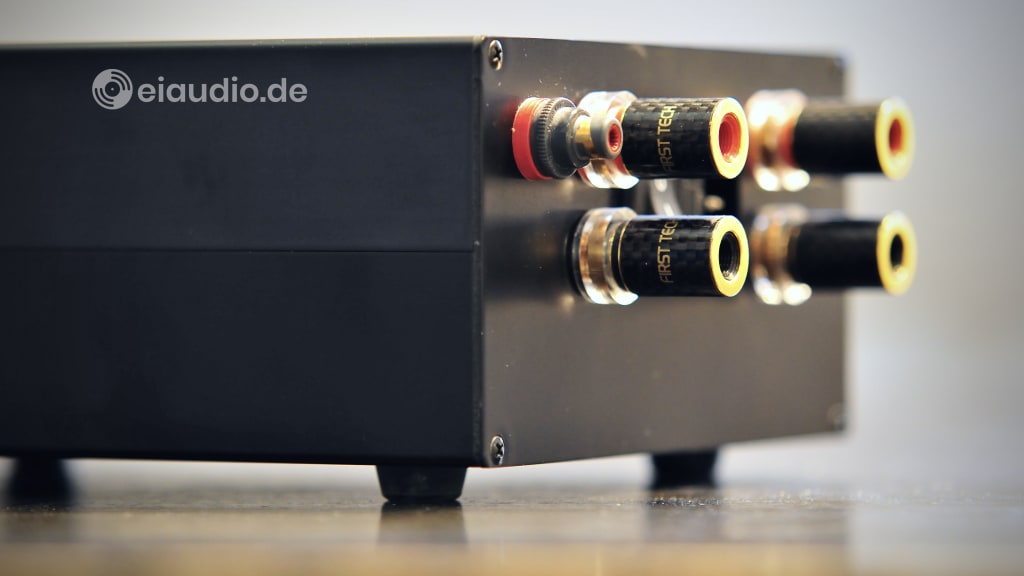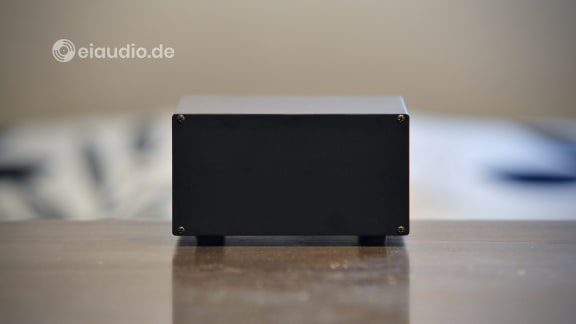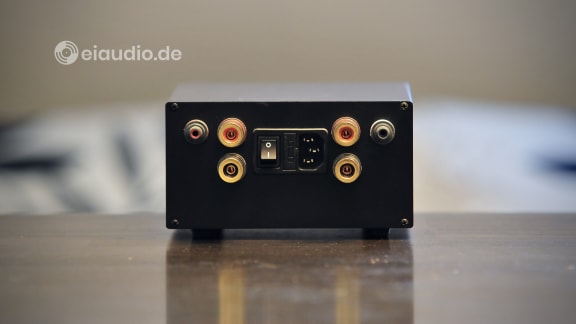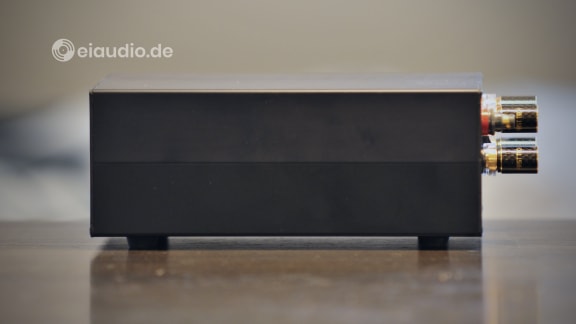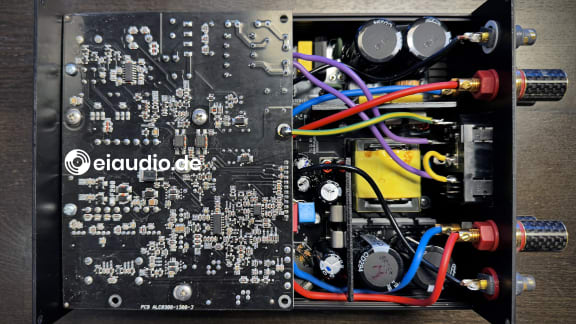High Output Class-D Amplifier
19/12/2022
Author: Karsten Hein
Category: Gear & Review
Tag(s): Power Amplifiers
“Have you ever tested a digital amplifier in your blog?” my favourite audio technician asked as I was leaving his shop. I stopped at the door and shook my head, grinning widely. I knew that Winfried was a seasoned developer of HiFi equipment ranging from network filters, CD-players, network players, pre and power amplifiers, all the way to loudspeakers. His more recent gear was usually packaged in inconspicuous-looking black boxes of visual understatement. And I knew that his digital amplifier designs had already been tried and tested in his own laboratory and in combination with the various HiFi gear of his customers. This particular Class-D amplifier had a higher-than-usual power output of 350 watts per channel into a 4-Ohm load.
“Will it work on the Martin Logans?” was my return question. We both knew that the Martin Logan electrostatic speakers produced some destructive dips in resistance, especially in the higher frequency spectrum. Winfried was confident that low resistance should not be problematic with his Class-D amplifier and assured me that there was built-in protection against overstraining of the circuits. I said that I would be thrilled and honoured to give his unit a try in my own testing environment. He handed me the amplifier, and, holding the little black box in just one hand, I was again reminded of the most obvious virtues of such a design: weight and size. At under 2.5 kilos, it was five to ten times lighter than a conventional 350 watts power amp would have been, even when considering some weight-stripped PA gear. I was thinking of such classics as the Dynacord PAA 880 power amplifier weighing 23 kilos.
As I had already experienced the Eichmann Bullet Plug’s advantage of equal mass ratio and also been witness to the benefits of solid-core connectors in eliminating Eddy currents, I was intrigued to learn about WBT’s 0210 CU Nextgen Plasma-protect sockets. What a positive surprise that Winfried should have chosen these plugs for the Class-D amp’s line inputs. The reassuring first impression continued when I turned the amplifier on for the first time. The integrated power switch on the IPC socket felt smoother and firmer than the many similar looking ones I had experienced before. The small black box looked sleek and sophisticated on our bamboo amplifier base, however, I could detect the slight ringing from the switching power supply that was emanating from the amplifier housing itself. It is no secret that I was no fan of trailing edge supplies and tried to eliminate them in our house wherever I could. On the other hand, I was prepared to keep an open mind towards the advances of technology.
During the warm-up phase of our equipment, the Class-D amp’s protective circuits detected a small amount of DC leakage coming from our tube preamplifier and switched the amplifier ouputs off repeatedly. This effect subsided once the Dynaco PAS-4 was at full operating bias. As our old Hafler XL-280 dinosaur had not featured such sophisticated circuitry, it had not revealed the small but not insignificant error on the side of the PAS-4. It took about 20 seconds for the Dynaco to stabilise, and the unpleasant switching noise stopped. Relieved that all was in good order, I assumed my listening position and noticed that the Class-D amplifier was itself quiet except for the small amount of familiar tube hissing coming from the Dynaco preamp.
When listening to Robby Williams’ album “The Christmas Present” on our Rega Planet CD player, I noticed that the Class-D amp played louder than our Hafler. It was quite typical for American amplifiers to have lower input sensitivity than their European counterparts. I could also hear that Winfried’s amp pushed the Martin Logans’ electrostatic panels into the higher frequency range more effortlessly. The resulting sound was accurate and smooth with great natural dynamics. The high frequencies sounded clean, and I felt that the tonality presented was natural. I was pleased with the amount of bass slam and control, and it was obvious that this amp was running stable enough to handle complex loads. Our hybrid Martin Logan speakers certainly qualified as complex loads due to their combination of panels (electronically similar to a capacitor) and dynamic bass driver. In this scenario, less able amplifiers than Winfried’s Class-D tended to struggle keeping control of the woofers.
The combination of the amp’s high damping factor 4,000:1 and its low internal resistance of less than four milliohms actually made it an excellent companion for our Martin Logans’ needs. I noticed that sonic events had their own spaces and sizes, without any apparent influence on each other. This was a great amp for analytical listening. The Hafler, on the other hand, seemed to paint with a single brush. It produced great cohesion in the music, but it could not match the Class-D’s superior bass control, extended high notes and effortlessness. While the Class-D design was able to produce growling bass that was deep and extended, the music could seem strangely disconnected at times. When playing music from digital sources, I sometimes felt a lack of emotion, a certain emptiness that was similar to the effect that is perhaps familiar from an LED cob light. While the light might be bright and also set at the specified colour temperature, there is also a sensation of emptiness when compared with a halogenic light source. And while this is just an analogy, the emmotional impact on the spectator was the same.
Playing music from an analogue source, however, was a completely different story. Here the amplifier’s additional detail and drive worked very well. The music sounded richer, fuller, and more satisfying. Phono benefited from the increase in agility coming from the Class-D design, and in contrast to digital sources, phono did not produce any feeling of emptiness. It instead sounded rhythmical, smooth, and full.
In conclusion, I could report that Winfried had built an inconspicuous-looking Class-D amp that packed many of the Class-D advantages but could not eliminate all possible design weaknesses associated with Class-D. In combination will digital devices, this particular amp could sound overly exact with some speakers and result in music information that was more interesting for the listener’s head than satisfying for the heart. In combination with analogue signal sources, however, the superior exactness had some obvious advantages. I could not help but wonder, if a linear power supply would not have resulted in an even better amp, but then this might just be my long-harboured personal suspicion of switching supplies.
Specifications
- Damping factor: 4,000
- Output power: 220 WPC (@ 8 Ohms), 350 WPC (@ 4 Ohms)
- Amp-internal resistance: 4 mOhms
- Switching power supply: 2x 600 VA
- Total harmonic distortion: <0,01 %
- Signal to noise ratio: 110 dB
- Channel separation: >115 dB
- Output impedance: 2-16 Ohm
- Line input sockets: 2x Cinch/RCA
- Input socket type: WBT 0210 CU Nextgen Plasmaprotect
- Speaker binding posts: FineTech, gold plated
- Total weight: 2.44 kg
- Dimensions: (W) 165mm; (D) 260mm; (H) 93mm
- Country of manufacture: Germany
- Year: 2015


